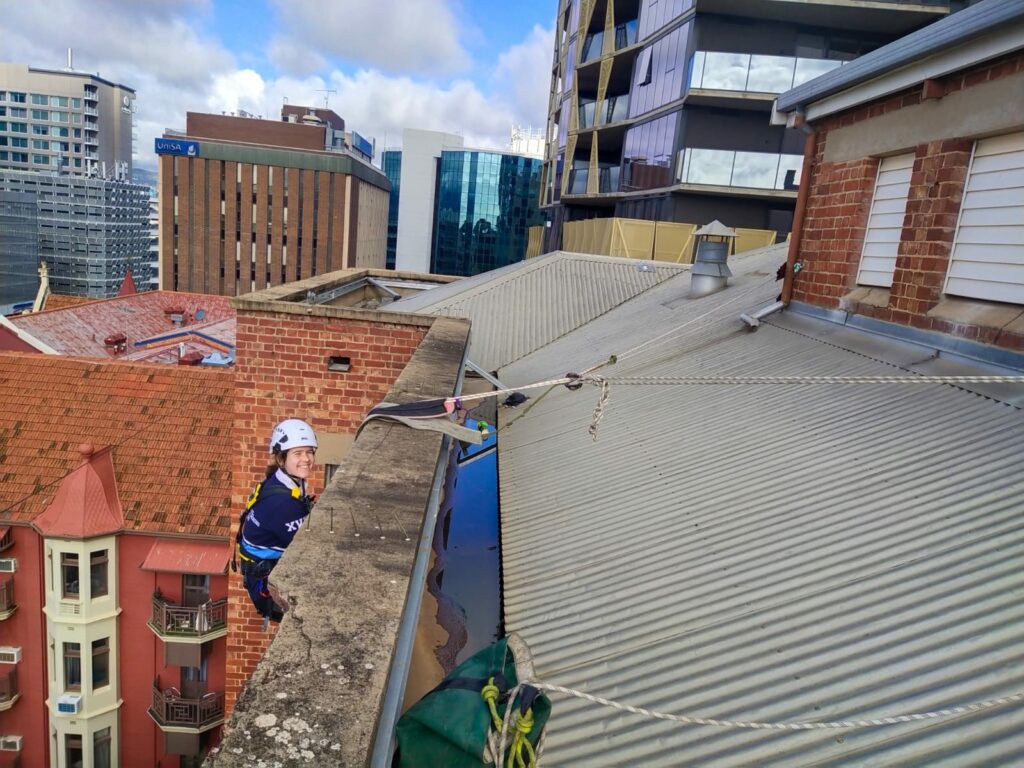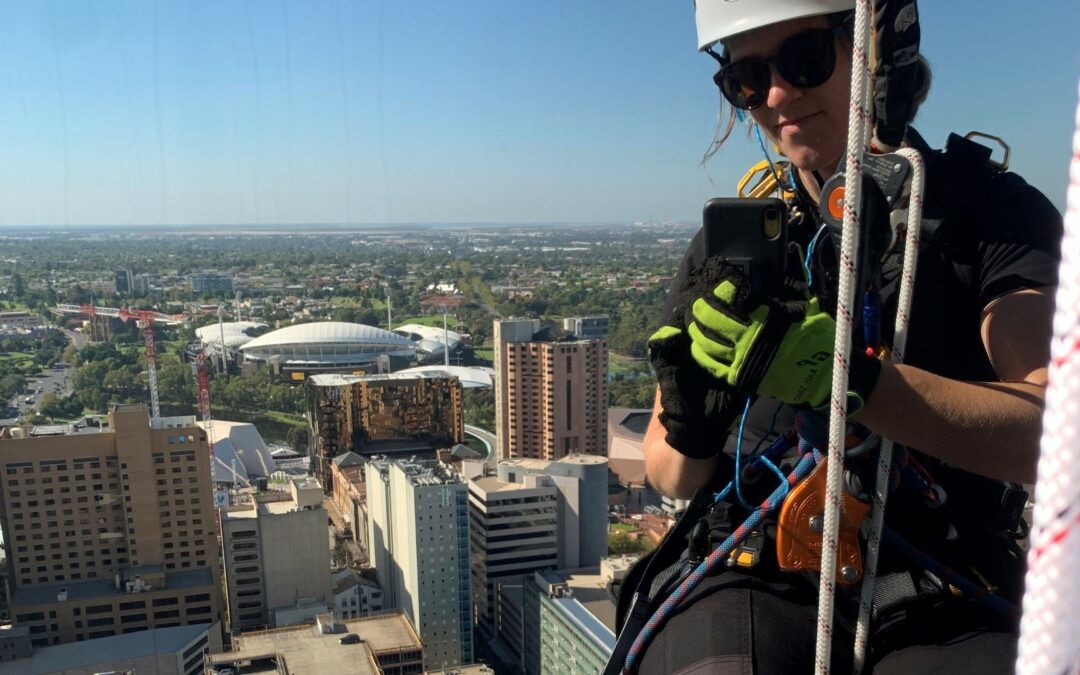Pictured: Arup-EWB Partnership Coordinator, Hannah Jury, is reaching for new heights in her role as a façade engineer.
It’s not all calculations and writing reports when you’re an engineer. Sometimes you’re abseiling from some of the tallest buildings in Melbourne’s CBD. Or at least that’s what a ‘day in the office’ can look like for façade engineer, Hannah Jury.
Restoring, repairing and replacing facades
Four years ago, Hannah leapt out of a Bachelor of Civil and Architectural Engineering degree from the University of Adelaide and straight into the graduate program at Arup as a façade engineer. Despite not knowing exactly what a façade engineer does, Hannah was eager to find out.
Weeks into the job, Hannah heard of fellow façade engineers conducting building inspections via abseiling – and thought that sounded pretty amazing. Years later, Hannah urged Arup to support her in completing the IRATA Industrial Rope Access Certification herself. After a week of gruelling and physically demanding training, she now holds an abseiling licence and uses it regularly to conduct monthly inspections across Australia.
“I might be the only female abseiling engineer in Melbourne!” reckons Hannah.
But it’s not just the thrill of abseiling from some of Australia’s tallest buildings that gets Hannah up in the morning; it’s her passion for sustainability that truly drives her. Façade engineers aren’t typically associated with driving environmental and sustainable development, yet Hannah believes they play a critical role in minimising the carbon footprint of new and old construction.
“It doesn’t matter what kind of engineer you are, there’s always going to be an opportunity to influence sustainability outcomes.”
 Hannah abseiling from a building in Melbourne to conduct a facade inspection.
Hannah abseiling from a building in Melbourne to conduct a facade inspection.
Hannah’s day-to-day work sees her working closely with architects and design consultants to develop façade systems for new constructions that are built for longevity. She examines a range of factors including thermal performance, watertightness, airtightness, daylight, durability, constructability, fire performance, access and maintenance. For existing constructions, Hannah inspects the façades of buildings requiring repairs, diagnoses the issues and develops strategies to repair or replace façade elements. It’s here that Hannah has found her passion for restoring some of Australia’s oldest buildings.
As Hannah explains, “Regular inspection helps us identify defects and deterioration early so we can recommend robust remediations, keeping the building looking good and performing well. The best low carbon building strategy is to avoid building at all, so I’m stoked to be helping extend the lives of our Australian building stock!”
From Ingenieure Ohne Grenzen to EWB Australia
When she’s not abseiling, Hannah volunteers her time with EWB Australia as the Arup-EWB Partnership Coordinator. However her journey with EWB didn’t start in Australia; she first came into contact with the Engineers Without Borders network over seven years ago when studying overseas in Germany.
Whilst on an exchange trip in 2014, Hannah joined Ingenieure Ohne Grenzen’s (EWB Germany) Aachen University Chapter and started delivering Youth Outreach workshops to local schools. Hannah remembers delivering workshops to classes with Syrian refugees. To build the confidence of refugee students, the Chapter members would write the instructions for activities in Arabic and ask the Arabic-speaking students to explain the activity to the German-speaking students. It was Hannah’s first experience delivering workshops to school-aged children, and she was hooked from the start.
Returning to Adelaide after her exchange trip, Hannah was eager to continue volunteering her time in the outreach space. After speaking to an EWBer friend from university, Hannah signed up as the University of Adelaide Chapter’s School Outreach Coordinator.
“It seemed like a cool way to advertise engineering to students who wouldn’t have as many opportunities as I did.”
 The University of Adelaide Chapter preparing to deliver a Youth Outreach workshop.
The University of Adelaide Chapter preparing to deliver a Youth Outreach workshop.
After completing her degree, Hannah moved to Melbourne in 2019 to commence Arup’s graduate program. Keen to meet new people through the EWB network, Hannah joined the local Victorian Chapter and soon after started volunteering her time in her current role as Arup-EWB Partnership Coordinator. In this role, Hannah supports the long-standing partnership between EWB and Arup and helps enable Arup’s pro-bono support for EWB’s engineering projects in Australia and overseas.
One of the projects Hannah recently supported was the Rawa community school upgrade project in Kunawarritji, a remote community in the Pilbara. For this project, Arup supported the design of a basketball court and accompanying shade structure for the school, which was the first recreational sports facility in the town. Hannah spoke to Arup staff and identified colleagues skilled in structural design, civil design, geotechnics and wind engineering who could help support EWB’s work with the architects and community to develop an efficient design. Hannah also continues to support the delivery of EWB’s Youth Outreach program.
Hannah’s advice for aspiring STEMinists
Hannah considers herself lucky to be an engineer, as her all-girls high school always encouraged its students to pursue male-dominanted careers. However she knows first-hand through her experience delivering Youth Outreach workshops that this isn’t always the case. Her advice for the next generation of STEM changemakers?
“Girls feel like they need to know everything back to front, inside out before they have the confidence to go for something… [But] you don’t need to be able to write a textbook on maths or science. You don’t need to be an expert, you just need to be able to use the concepts that you learn.”
“STEM and maths can feel daunting because it’s just these random numbers with no meaning. For me, I found that once I applied the maths to the engineering it was no longer just XYZ but actual things that relate to the real world… That really helped me. There’s a real reason why I’m doing this and it’s less abstract. Maths has a real application with engineering and it’s not as scary…”
Through her work with EWB, she hopes to encourage young girls to have the confidence to consider a career in STEM, because you never know where engineering might take you – as Hannah knows, some jobs can take you to surprising heights.
Video edited by Olivia Hough.
About the ‘Futur-neers’ program: This series is funded by the Australian Government Department of Industry, Science, Energy and Resources through the ‘Women in STEM and Entrepreneurship’ grant program. The program focuses on deeper support and amplification of EWB’s Youth Outreach volunteer network, with a particular focus on empowering women in engineering.
To read about our other incredible ‘Futur-neer’ role models in the EWB Chapter network, click here.


